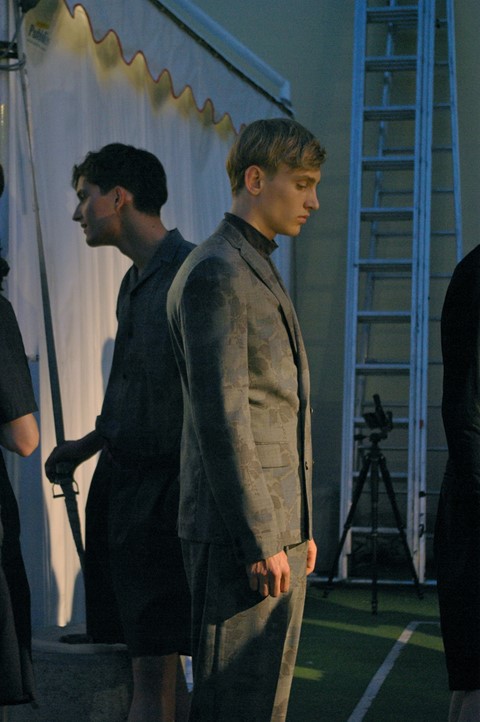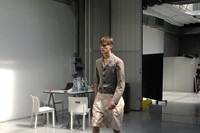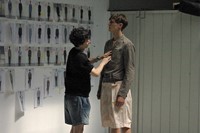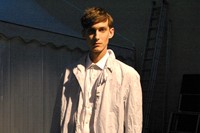AnOther goes backstage at the Pitti Immagine tradeshow.
There is an unconventional and striking elegance in the way that Japanese men have adopted Western sartorialism – the ease with which they can pull off a three-piece suit or a mismatched jacket and shorts, for example. Every season the Pitti Immagine tradeshow is traditionally the first showcase of this natty style, as the hoard of buyers and press hop their way from Florence across to Milan and finally Paris to watch, report on and eventually buy the next season’s fashions.
One designer who has always exemplified this East-West tradeoff in his work is Junichi Abe, the man behind the brand Kolor, Pitti Uomo’s guest menswear designer for SS14. Abe’s schooling at BUNKA college in Tokyo and the years spent behind the scenes at Yohji Yamamoto and Junya Watanabe have distilled an inherent sense of the avant-garde in his work – albeit one that shines through in construction and fabrication rather than superfluous embellishment and wild asymmetries. The collection he showed on a raised blue runway above the astroturf of a Florentine sports field was subtle at first take, yet upon review was awash with technical detail and jaunty flair. Based on variations of sporty shorts suits and luxe sportswear propositions in panelled, technical fabrics, topping off the silhouette with soft bucket hats and grounded it on beaded sandals and panelled topsiders.
"It’s all about how Abe starts developing fabrics. He makes the fabrics himself, he develops new ways of putting two threads together that don’t belong together”
AnOther went backstage after the show to experience the looks up close, away from the hyper-colour projections that lined the catwalk, obscuring the live-streaming video of the garments in a patchwork of light effects. Speaking to Abe’s stylist Hannes Hetta, what emerged from the collection was an appreciation of Florence (albeit abstract) coupled with a designer’s unerring dedication to patternmaking, research and development. “When Junichi came to Florence to see locations, he felt the history – but the collections isn’t about the weight of history – more about a clash with it” said Hetta, “The space that he chose says a lot I think. In Florence you could be in a palazzo but here we are in a football field, yet there is still this high, old wall behind”. It was that wall that took centrestage in the presentation, as guests watched the runway from a sideview – facing the projected figures of the models cast across the wall in realtime, offering front, back and side view of the garments all at once. “He’s never done prints before. Hawaiian print for him has a meaning which says ‘happy’,” explained Hetta, pointing out the hibiscus and bird of paradise prints that shadowed across a double-breasted blazer or trimmed wide, paperbag shorts.
“His design and his concept of fashion is about the design itself – he’s not one of these designers who draws his inspiration from an era, or a feather or an object or a movement. It’s all about how he starts developing fabrics. He makes the fabrics himself, he develops new ways of putting two threads together that don’t belong together. He manipulates polyester into silk, boils it, to make totally new textures”. An ice blue mackintosh that billowed out behind its wearer highlighted this technique, as did blazers ruched down the front and sleeves. “His work is all in the details. Like the nylon trench”, continued Hetta “it’s a fabric that is never used for clothing, and it is shrunk from three times the size to create the scrunched effect. For me as a stylist today, I see there are some designers who are more like stylists – picking a reference from an era and a look then mixing it and matching it together. What Junichi does is very ‘inclusive’ design – maybe you don’t need to wear a total look of Kolor, but I think men out there just want to see something that isn’t forcing you into an era or an idea or a mood, but something that is technically well done as a garment. “
Text by Dan Thawley



